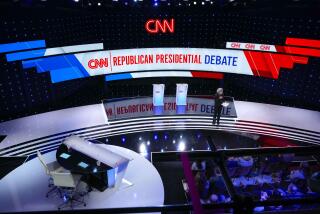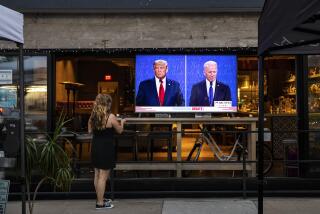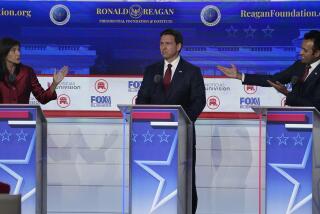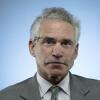Party conventions still matter as a political reality show
When Democrats and Republicans gather for their national nominating conventions, star-spangled in silly hats and their donkey and elephant jewelry, some may see it as a colossal waste of time and money.
Decades have passed since the last time convention delegates actually decided a presidential nominating fight. The selection of a running mate, which used to be a big part of the drama, now occurs well ahead of the opening gavel.
Given the lack of suspense, the major TV networks, which once competed with blanket coverage, have cut back in recent years to a scant one hour of prime-time programming each night. Politicians in both parties have made a point of saying they would skip the events entirely.
Despite all that, however, the conventions are more than a lavish self-indulgence — funded to the tune of $36 million in taxpayer dollars — for the presumed nominees, or a chance for thousands of party faithful to revel in the subtropical heat and humidity of Tampa, Fla., (for the Republicans, starting next Monday) and Charlotte, N.C. (for the Democrats, beginning Labor Day).
Utterly predictable as they may be, the conventions still draw huge TV audiences, many tuning into an abundance of cable networks that have taken up the slack in broadcast coverage. More people watched then-Sen. Barack Obama’s colonnaded convention speech four years ago than the finale of “American Idol,” the Academy Awards or the Olympics opening ceremony in Beijing. A week later, about 39 million people tuned in for Sen. John McCain’s acceptance address, topping Obama by about 500,000 viewers for the biggest television audience in convention history.
Like the Olympics, which draw tens of millions of viewers who otherwise care little about track and field or the 200-meter butterfly, the conventions are event TV, attracting people who usually pay scant attention to politics. Apart from the fall debates — when the candidates will be forced to share a stage not just with their rivals but also with people asking them questions — no political event will likely draw as large an audience between now and November.
“It’s four days … for the parties to get out their message more or less unfiltered,” said Russ Schriefer, chief convention strategist for Republican presidential hopeful Mitt Romney. As such, it is one of the prime sales opportunities of the campaign.
Granted, Schriefer and others said, the country is deeply polarized. Many convention viewers will tune in simply to cheer the good guys (their side) and jeer the bad. But there are still plenty of undecided, or at least persuadable, voters who will watch the conventions and, especially, the candidates’ acceptance speeches as a way to start making up their minds.
Ronald Reagan in 1980, Bill Clinton in 1992 and Al Gore in 2000 all got big lifts out of their conventions, long after the drama and most spontaneity had been banished from the proceedings. Clinton, who entered his convention facing serious doubts about his personal character and political viability, recast his image almost overnight, thanks in no small part to his slick team of Hollywood producers.
Most candidates, though, have been happy to walk away with modest, and short-lived, bumps in the polls. That is because modern conventions have become, to a large degree, carefully scripted, meticulously choreographed attempts to minimize risk.
The list of things that can go wrong is a long one that includes internal dissension (a hapless President Carter was caught onstage at the close of his 1980 convention chasing his Democratic primary opponent, Massachusetts Sen. Edward M. Kennedy, in a vain attempt at a conciliatory handshake), an off-putting tone (insurgent Patrick J. Buchanan and others greatly undermined President George H.W. Bush’s reelection bid with their strident speeches at the Republican 1992 convention), or the ultimate in convention disasters, rioting and blood in the streets (Chicago, Democrats, 1968).
The selection of a vice presidential running mate can be especially perilous. Thomas Eagleton was bounced from the 1972 Democratic ticket after reports surfaced of his electroshock treatment for depression, and Republican Dan Quayle never fully recovered from his disastrous debut as Bush’s surprise pick in 1988. That was the last time a presidential candidate announced his vice presidential choice at the convention, which had replaced the old way of letting delegates make the selection.
If it makes for less than edge-of-the-seat excitement, the campaigns have become skilled at injecting just a smidgen of drama (a gallant appearance by the dying Sen. Kennedy at his final convention in 2008, the boffo debut of Sarah Palin the following week) to keep people watching.
“Of course they’re scripted,” said Democratic strategist Bob Shrum, who has attended virtually every party convention since 1960, and helped stage a few. “But they can still have their powerful moments.”
As much as the conventions are geared to those watching at home — think of it as a four-day political reality show — the gatherings are also important for party-building and unity purposes. By bringing loyalists under a single roof, the parties can organize and energize their troops for the final push, which, given the Democrats’ late convention, will leave scarcely two months to campaign before Nov. 6.
Conventions also give the parties a chance to showcase their up-and-coming talent.
It was, after all, a widely praised 2004 keynote address that launched Obama on his path four years later to the White House.
Conventions obviously matter a good deal less than when “they were actual deliberative bodies deciding the nomination,” said David Axelrod, the president’s chief political strategist. “But there are still people out there watching. Nobody knows that better than us.”
More to Read
Start your day right
Sign up for Essential California for news, features and recommendations from the L.A. Times and beyond in your inbox six days a week.
You may occasionally receive promotional content from the Los Angeles Times.







